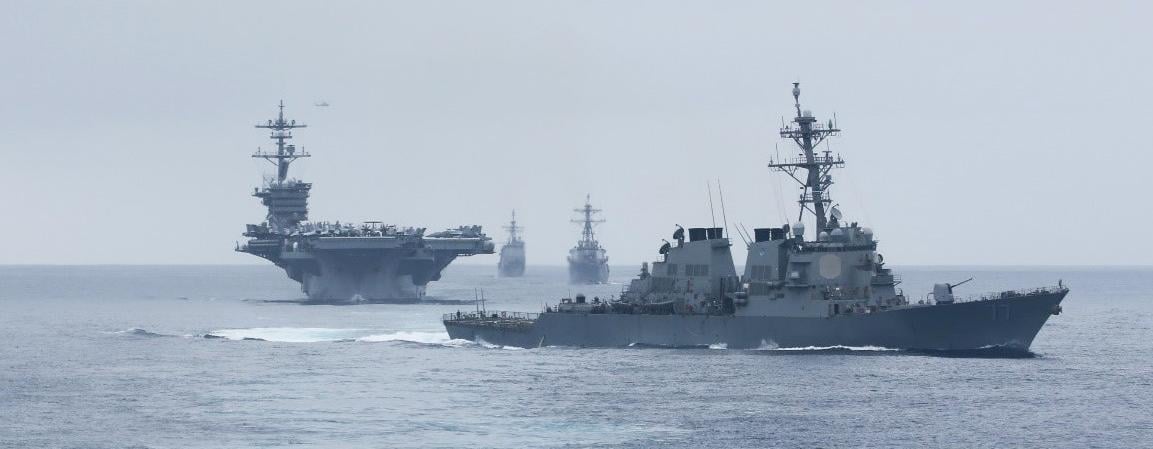Show of Strength or Brinkmanship? Debating the Merits of Gunboat Diplomacy in the 21st Century.
As the U.S. Army Engineers toiled in the blazing Gaza sun, and a battle raged in the vicinity, a temporary pier to facilitate the docking of ships carrying humanitarian aid to Gaza gradually took shape. Under heavy international condemnation for its unstinted support to Israel over the Gaza war, the U.S. has been working hard to earn some brownies points through this much-publicised jetty. It is a different matter that storms put the jetty out of commission even before it could be operationalised fully and remains under repairs.
This display of military capacity for a positive goal contrasts the usual practice of big powers who send their naval might to threaten errant nations. The end results are the same—the achievement of national policy goals! It is also being hailed as a timely demonstration of the effectiveness of the U.S. watercraft strategy aligned with the demands of the 21st Century.
Background
Global projection of power, or Gunboat Diplomacy, needs to be sustained by a matching logistical capability. American forces perfected their watercraft strategy in the opening stages of World War II when over 127,000 watercraft of various types were in use, supporting U.S. naval and military forces fighting all over the Pacific.
Just last year, the United States traversed the depths of the Pacific Ocean, moving across Hawaii to Australia in an exercise that tested logistical sustainment in a contested environment to deter China and protect its allies. In the case of the Gaza pier, the same strategy is being showcased. The vessel can build a floating pier to provide humanitarian assistance to civilians in the war-torn region. The ship can travel long distances without requiring a port to dock and a small crew.
China’s actions in the South China Sea and Russia’s annexation of the Crimean Peninsula back in 2014 all point to their interest in attaining their objectives using naval power. While the end goal of each of these exercises appears to be different, they all are a manifestation of the age-old ‘gunboat diplomacy’. Typically equated with Roosevelt’s ‘big stick’ policy, this form of diplomacy has been around the corner since 1853 when the U.S. sailed four of its ships to Japan’s Tokyo Bay to coerce the country into opening its trade routes with the West.
The term, as understood widely, refers to the threat or use of limited naval power, either to deter or contain the actions of the adversary to prevent the furtherance of conflict. Falling right into the hands of coercive diplomacy, it is catalytic, designed to deal with an unspecified threat. Summing up this ‘shows of force’ tactic, Henry Kissinger said, “An aircraft carrier is 10,000 tons of diplomacy.”
Analysis
Gunboat diplomacy, which allows countries to act as “active but passive” bystanders, can be better understood once the intent of the countries employing this strategy becomes clear.
The United States, being an expeditionary force, has always operated at the fringes of the third world to further its national interests. No Indian can forget the steaming of the powerful U.S. 7th Fleet towards the Bay of Bengal even as the Indian Army was entering Dacca to bring the 1971 Indo-Pak conflict to a swift and decisive end. Now, the picture has changed, and Indian and U.S. naval platforms regularly conduct joint exercises all over the vast expanse of the Indian Ocean, sending a loaded message to China, a growing naval military power in its own right. The massive watercraft exercise conducted last year by the U.S., mentioned earlier, was in line with this modern strategy to deter potential naval threats, in this case, the growing presence of the PLAN in the Pacific.
China, as its blue water naval capacity increases at an amazing rate, has also started perfecting the art of coercion through naval manoeuvres. This is daily on display in the disputed South China Seas, where the PLAN regularly disrupts routine fishing activities as well as flexes its muscles to exert its claim over the vast EEZ that it has unilaterally promulgated in the region with scant international sanction or acceptance. Taiwan is another maritime flashpoint, with the narrow Taiwan Straits being the stage for military coercion at its most blatant. In doing so, China aims to advance its vital national interest of unity and territorial integrity.
Chinese justify their resurgence to the historical embarrassment that the country had faced from foreign navies that used gunboat diplomacy to exploit China when it was under weak central control. In fact, the term Gunboat diplomacy originated in the early 19th Century when Great Britain and France used their superior naval power to browbeat China in what is called the Opium Wars. The almost century-long Yangtze Patrol, also known as the Yangtze River Patrol Force, was a prolonged naval operation from 1854 to 1949 to protect American interests in the Yangtze River’s treaty ports. The Yangtze Patrol also patrolled the coastal waters of China, where they protected U.S. citizens, their property, and Christian missionaries. It should, therefore, be of little surprise for China to follow a more nationalistic and hawkish defence policy, through which the country aims to unite its former territories with the mainland. The South China Sea has been labelled a ‘core interest‘; hence, the aggressive actions towards the Philippines and other littoral ones follow.
Considering the deterioration in Russia’s military capacity after the demise of the Soviet Union, its naval deployment to the Australian shore could be more of a symbolic move than a military one. Moscow found it imperative to remind the world that it remains a great power, carving its way out of decade-long isolationism. Russian naval focus has been more forceful in the Black Sea, where it has been instrumental in strengthening Russia’s hold on the Crimean Peninsula since 2014.
In summary, it can be concluded that while Gunboat diplomacy is not dead, it has evolved into a more diffused shape, with large carrier groups acting as the instruments of national power projections. For this reason, aspiring powers like China and even India are expending vast amounts on commissioning exorbitant carrier groups. However, the essence of Gunboat diplomacy remains unchanged, widely influenced by the nature of the assailant, the nature of the relationship between the victim and the assailant, and the nature of the incident.
Demonstrating naval power has emerged as one of the major ways the great powers advance their national and economic interests. However, the question remains: is gunboat diplomacy effective in attaining the ends that countries seek?
If you consider the Taiwan issue, then the naval might of the U.S. is a factor that has deterred Beijing from invading the island nation. But this deterrence is being rapidly eroded as Chinese military power expands, and it will be more a concern for the economic fallout of such an invasion rather than the military confrontation with the West that may ultimately compel China to seek a peaceful solution to the question of the unification of Taiwan. In the South China Seas, Vietnam, the Philippines, Malaysia, and Brunei would have to accept Chinese suzerainty with a stiff upper lip, American promises notwithstanding.
In the same way, steaming a powerful U.S. Navy carrier group into any corner of the globe will remain a strong message for any nation threatening American interests, a signal that few minor powers or third-world countries can afford to ignore.
Assessment
- Gunboat diplomacy is a double-edged sword. Although containment of an adversary seems to be a boon of this art, stability and potential escalations remain a major bane. The costs outweigh the benefits. Other countries could jump into this sabre-rattling, unfavourably impacting the geopolitical order.
- Unsolicited use of naval power to bully smaller and weaker nations is no longer acceptable to the larger global community, even if the United Nations has miserably failed to live up to its high expectations. Ultimately, diplomatic parleys would have to replace the menacing grey silhouettes of warships looming on the horizon, threatening death and destruction with their firepower.
- The growing competition between China and the U.S. on the high seas is a disturbing development that could have serious repercussions for global stability. A relatively low-ranking captain of a major surface combatant has enough firepower at his fingertip to trigger World War III!




